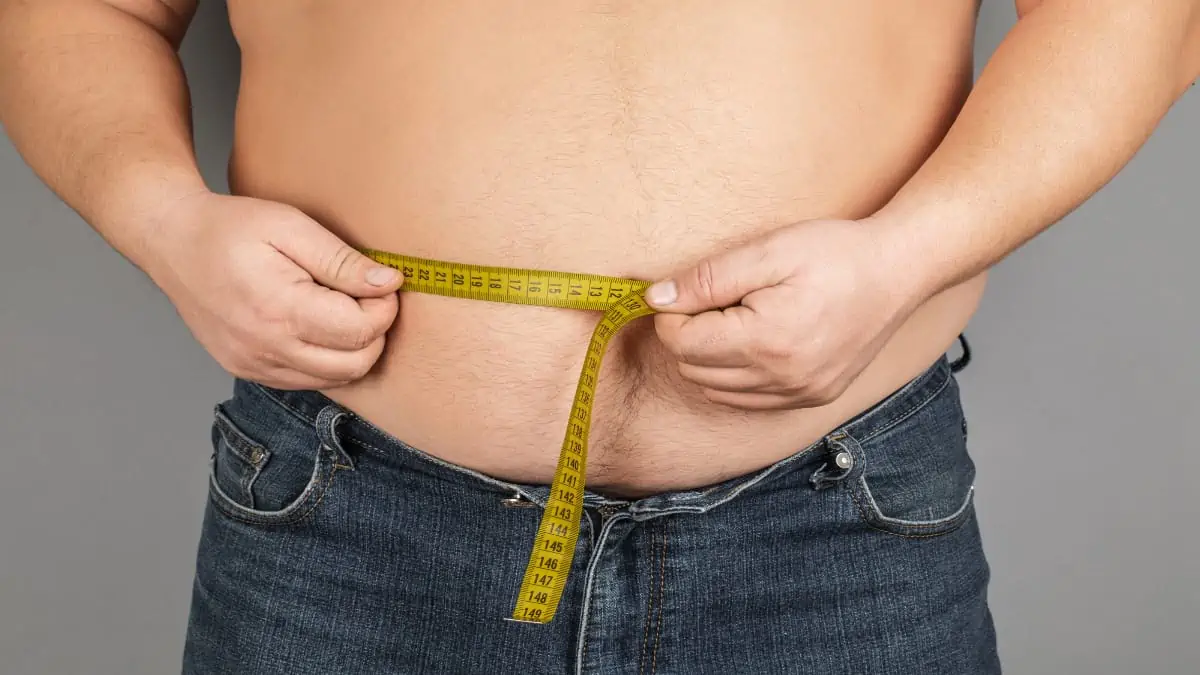A 44 inch waist is around 6 inches bigger than normal for a woman and approximately 4 inches larger than the average male waist size.
With these sobering statistics in mind—bear in mind the average measurements are already too large for people to live in their best health—this guide seeks to explain how you can safely and effectively slim your 44 in waist.
But first, let’s explore the health dangers of having a 44″ waist. You can also see our other articles to get guidance for similar waist measurements.
How big is a 44 inch waist?

While your build, height, and gender all affect how big a given waist size is, a 44 inch waist is almost universally too big for anyone to enjoy their best health and physical wellbeing. This is because having an excessively large waistline is associated with higher all-cause mortality—regardless of your BMI. [1]
So, even if your BMI is only just in the overweight category, the fact that you have a 44 inch waist overrides this because we know that excess stomach fat (often called visceral fat) can increase your risk of conditions like heart disease and diabetes.
So although a 44 inch waistline isn’t that much bigger than average in terms of appearance, it’s still well above medically accepted cut-off points for being at a low risk of chronic disease.
Of course, you can be happy with your body while having a 44 inch belly. Indeed, there are ripped weight lifters out there who, despite having plenty of muscle mass and a low body fat level, are still unhappy with their physique. So it just goes to show that your perception of your own physique is most important when it comes to body satisfaction.
Additionally, women often naturally accumulate more belly fat as they reach menopause, whereas men typically store more fat on their stomachs than on their legs and hips by default. [2]
Is it bad to have a 44 in waist?

While you can be satisfied with your 44 inch waist, you simply can’t live in optimal health (or anywhere near it) while having such a waist size.
An excessively large waist circumference is associated with an increased risk of stroke, high cholesterol, and also high blood pressure. [3]
So while you shouldn’t feel obliged to have a slim body—most people don’t—you definitely need to shift some stomach fat if you want to live in good health.
Thankfully, losing weight comes down to achieving one simple physiological state.
How can you safely slim your 44″ waist?

Successful weight loss necessitates that your body is in an energy deficit. To create an energy deficit, you need to increase your activity level and eat fewer calories than your body needs to maintain its current weight.
So, if you’re currently gorging on 3000 calories, drop your intake down to 2500 calories and see if that leads to weight loss. It very well may result in a good weight loss of one pound per week—especially if you’re exercising as well.
Intense exercise is a great way to burn calories in a short amount of time. Plus, with movements like squats, burpees, and mountain climbers (which require zero equipment), you can work out from the comfort of your own home.
Walking is also a great place to start. A brisk walk in the park gets you outside in the fresh air while burning calories and aiding your digestion in the process. Always try to go for a walk every single day so that you stay active and avoid becoming sedentary (being sedentary can lead to weight gain).
The verdict: How soon can you see results?

You can and will experience weight loss within the first week of being in an energy deficit (if you don’t, then you’re not in an energy deficit).
However, in order to see meaningful reductions in measurement, you’ll need to wait a month at least.
You shouldn’t worry if you don’t see massive changes straight away. It can be helpful to track your weight on a daily basis (make sure to weigh yourself at the same time) so that you can see the incremental changes, which let you know that you’re on the right path.
While being in a calorie deficit is the most important prerequisite for weight loss, you shouldn’t eat processed foods because they tend to lack nutrition and aren’t very filling. Instead, stick to whole foods and eat a balanced diet. There are many healthy and tasty foods at your disposal, and delicious recipes are only a cookbook or internet search away.
References
- Staiano, A. E., Reeder, B. A., Elliott, S., Joffres, M. R., Pahwa, P., Kirkland, S. A., Paradis, G., & Katzmarzyk, P. T. (2012). Body mass index versus waist circumference as predictors of mortality in Canadian adults. International Journal of Obesity, 36(11), 1450–1454. https://doi.org/10.1038/ijo.2011.268
- Callahan, A. (2022, January 11). Why Do Women Gain Belly Fat in Midlife? The New York Times. https://www.nytimes.com/2022/01/11/well/move/belly-fat-women.html
- Foulds, H. J., Bredin, S. S., & Warburton, D. E. (2012). The relationship between hypertension and obesity across different ethnicities. Journal of Hypertension, 30(2), 359–367. https://doi.org/10.1097/hjh.0b013e32834f0b86

